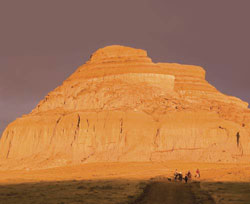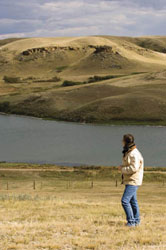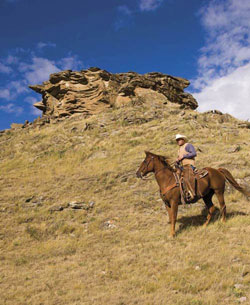The Undiscovered Country
 |
|
Ablaze in the sunset, the formidable clay and sandstone formation of Castle Butte served as a landmark for early explorers and settlers. Multi-generational ranching family Ryan and Carla Froshaug of Minton, SK and their children, Shyla, Shana and Tanner are riding along the trail leading to the promontory.Photo Credit: Paul Austring |
I love Saskatchewan. The sky is bigger, the wind is fresher, the people are friendlier and the history and country is wilder than any Hollywood scriptwriter could dream up. I was heading south, deep into the land of legendary outlaws, medicine wheels, massive ranches, ceremonial circles and undisturbed buffalo jumps. This is the last remnant of the Wild West – the undiscovered country of the Big Muddy.
Located straight south of Regina, the Big Muddy Valley is truly one of the more spectacular regions of the province. Just north of the Medicine Line (U.S. border) the towns of Big Beaver and Minton are the outposts of this region. Thousands of years of rich First Nations history is still widely evident in the massive and mysterious boulder effigies scattered across the vast landscape. No one can say for sure which peoples made the effigies. Some human or animal figures tell of personal or tribal tragedies. Some mark the resting place of important tribal members. Some mark battles. Some are unexplainable. The combination of topography and ranchers saved the sites; the same combination protects them still.
Big Muddy ranchers Michael and Tammy Burgess on the Circle Y are mindful of the historical importance of the sites and grant access to scientists, writers and visitors to the areas. The size of their ranch is immense; the day I was there Tammy thinks she may have discovered another medicine wheel while taking photos of the Three Sisters range. “I’ll call Ian and tell him,” she said. “Ian” is G. Ian Brace of the Saskatchewan Archaeological Society, author of Boulder Monuments of Saskatchewan and a frequent visitor to the Circle Y. I head out for the Giles Ranch.
Stand with your back to the outlaw caves on the Giles Ranch and the U.S. border is within rifle range – likely one of the disturbing thoughts that crossed the minds of the men pursued by the law. The draw for the outlaws to this area was the grass and water, the other was the seclusion. One of the most famous outlaws in the region was Butch Cassidy who called the Big Muddy area the “Devils Playground,” and who set up a trail of remote hideouts extending from Station # 1 in the Big Muddy, to the Hole in the Wall in Wyoming, Robber’s Roost in Utah on down to Ciudad Juarez in Mexico.
It wasn’t banks or railroad payrolls that fueled the Canadian side of the outlaw economy, but rather horses – stolen horses. Gangs would sell horses to homesteaders, steal them back and move them across the border, rebrand them and later bring them back across the line to sell to another group of unsuspecting homesteaders. The lawlessness had reached the N.W.M.P. and they established a post in 1902, sending five constables and one corporal to patrol the area on horseback, tempering the horse and cattle rustling. Constable Doug Minor rode the last official horse patrol of the Big Muddy on October 31, 1938.
Still on the Giles ranchland we traveled up onto the butte to the boulder-outlined Ceremonial Circle. The design resembles a large kidney, shaped by stones that, as my charming guide Harold Siggelkow of Coronach pointed out, probably held down the coverings of a ceremonial lodge. The immensity is startling; measuring 80 feet in length, 60 feet in width and is divided into two portions. Hundreds of tipi rings are evident on the tops of the surrounding hills.
Further along the edge of the butte is a turtle effigy. The head faces south overlooking the broad coulee and creek below. Scientists realized the boulder line extending from the tail to the neck of a turtle effigy indicates the direction to a water source, sometimes evident, sometimes a hidden spring. At one time, the outline of this effigy surrounded a burial cairn. The site has been radically disturbed by souvenir hunters and is now fenced to protect the remaining site.
 |
|
Seeing the big picture from across the valley on the Lichter Ranch, it becomes obvious why the Roan Mare Buffalo Jump was in constant use for thousands of years. The undulating landscape, still dotted with rock cairns that once held grass ropes to funnel the herds over the edge, rendered the jump virtually impossible to detect until it was too late. Close to a large source of water and plentiful grazing, the surrounding hills are covered in thousands of tipi rings. Terri Mason in the photo.Photo Credit: Paul Austring |
When we arrived at Castle Butte, we knew with one glance at the imposing monolith that the sheer scale of the site could only be realized with people in the photograph. Coronach town administrator Murray Setrum reached for his cell phone. “I’ve rounded up some cowboys,” he said, grinning conspiratorially. Soon a plume of dust rose from the valley floor and the Froshaug family of nearby Minton; Ryan and Carla and their daughters, Shyla, 8, Shana, 4 and their sons, Tanner, 6 and little Colter, 6 months, pulled up with a loaded horse trailer.
The multi-generational ranching family dropped what they were doing and came over to help us out. Creative loading got the horses, mule and pony in the stock trailer. “I’ll have to get a bigger trailer when Tanner goes to a bigger horse,” commented Ryan as he reached for the pony, practically under the grey mare’s belly. Ryan efficiently saddled the horses, Carla breastfed Colter and the kids strapped on their spurs. One glance at their outfit and I knew we had the real thing – cowboys. Rapid-fire photographer Paul Austring and his laid-back assistant, Dale Williams worriedly studied the leaden skies and planned their shots. I prayed; all we needed was a few moments of the setting rays on Castle Butte.
The kids were soon mounted and heading up the access road, Tanner’s lariat already whirling like a helicopter blade over his head. His pony ignored the rope; his sisters did too. He’d been warned off of roping his sisters. Ryan glanced up, “You’ve got a twist,” he casually commented. With a practiced flip, the twist was gone and the rope spun smooth again as Tanner urged the pony into a gallop, catching up to his sisters. “That pony doesn’t know he’s a pony,” Ryan said, a hint of pride in his voice. “I had roped a steer in the corral and suddenly there’s Tanner on the pony. He came in and heeled him slick.” The kids were now in the focal range of Paul. Carla handed the satisfied baby to one of the onlookers and she and Ryan swung into their saddles.
Test shot after test shot, the Froshaug’s patiently retraced the trail. The clouds hung heavy; just a hopeful sliver of clear sky hung tantalizing at the edge of the horizon. The gaggle of onlookers were pessimistic, doubting we’d get the light we were seeking. Paul teetered on the top rung of the stepladder. I prayed.
The sun slipped lower and suddenly the grey face of Castle Butte was awash in molten gold. “Look at that!” exclaimed the small crowd as Paul machine-gunned his camera. The coveted golden moment of photography arrived in a blaze of glory. The Froshaug’s rode tall; the camera fired and my guide Harold quietly exclaimed, “I never would have believed it.”
The next day we made plans to meet at the Roan Mare Buffalo Jump located on Tim and Kathy Lichter’s ranch, located some 22 km northwest of Minton. Once again, we wanted to show the scale. A quick call and it was arranged -– ranch manager Werner Skappel would meet us.
As we scouted the base of the jump, movement down the valley caught my eye. Two border collies raced each other, keeping pace with the cowboy on a loping sorrel. Young and ruggedly handsome, Werner rode easy in the saddle as he slowed the high-lifed gelding. His quiet confidence in his abilities to single-handedly manage the over 5,000 acre remote spread was evident; his confidence in front of the camera was a bit shaky. Compliment a working cowboy and you’ll make him nervous, admire his dogs and his horse and he’ll open up, rightly proud of his working partners. His horse, John, originally came from north of Edmonton. “I bought him out of a kill pen,” Werner said. “I liked his looks, bought him and trained him. He’s a good cowhorse,” he added proudly. His dogs, Sage and Sally, gaze at him with a mixture of adoration and impatience. “They like to work,” he added simply,
calling the dogs over for a quick belly rub.
 |
|
The Legend of the Roan Mare |
The Roan Mare Buffalo Jump loomed overhead. A faint trail circled the base of the Red Rock escarpment, a drop of 35 feet to a steep 135-foot talus slope below. The trail disappeared out of view. Loaded with gear we headed for the top, walking over thousands of years of buffalo bones, buried deep below the native grass. Once on top we could plainly see why this site was so popular, it was a perfect setup. Herds were gathered from the lands in the northeast, funneled the last half mile into drive lines, then stampeded over the precipice and slaughtered. “I almost rode over the edge once,” Werner commented. “I don’t come over here very often. I don’t like heights and I don’t like snakes.” Rattlers like to sun themselves on the escarpment, he told us. Casually, we move off the slabs of rock.
The Roan Mare Valley is typical of the Big Muddy area, with the surrounding hills and coulees primarily virgin shortgrass prairie. This is the largest of several bison kill sites in this valley. Some 7,000 small cairns of stones spaced approximately 8 feet apart comprise the drive lines and are still evident today. The valley floor, where large amounts of fire-cracked rock are found, was the processing area. Across the valley to the west are smaller kill sites, lines of rock, 1,627 tipi rings, possible sweat lodge locations and an unknown effigy. I find a hide scraper worn smooth from use and elements. I leave it when I go.
The following day I pulled into the pretty town of Willow Bunch to visit an old friend, former rodeo announcer “98,” Randy Gaudry. He moved back to Willow Bunch a number of years ago, telling me, “It’s the only place that feels like home.” His family’s roots are deeply entwined in the community, and a catalyst for Randy’s Métis pride was the pivotal role played by his grandfather, Andre Gaudrey, in the history of this area. In the foreword of the award-winning book, History of the Métis of Willow Bunch, Randy is prominently thanked for his contributions. Randy is starting up a tour company and he graciously insisted that I see the St. Victor Petroglyphs, now quite weathered and reinterpreted on signs. There’s nothing better than to visit a friend and find them in their element, his broad-ranging knowledge of the history, love of storytelling and personal connection to the Willow Bunch area made for a grand tour.
Heading for home, I choose the path traveled by those in the know – the road to the tiny hamlet of Hazenmore. It’s
here that, bar none, the best steak in Saskatchewan is served at the Red Coat Inn (or the Re Coat Inn if you approach the restaurant from the other side.) I go twice.
More than anything else, it’s the deep sense of place so much a part of the soul of the people that keeps me coming back. Archaeological treasures and dramatic landscapes are accepted as matter-of-factly as a six-year old boy heeling a steer. That’s just the way it is.
I love Saskatchewan.
 |
 |
 |
|
This sequence of photos shows the riding skills of young cowboy Tanner Froshaug. While his intent was to jump the ditch, both pony and rider appear to realize at the same moment that the ditch was wider than they thought and slammed on the brakes, a move that has unseated many a good rider – but not Tanner. Moving as one they quickly recovered, crossed the ditch and caught up with Tanner’s sisters. Photo Credit: Paul Austring |
||













